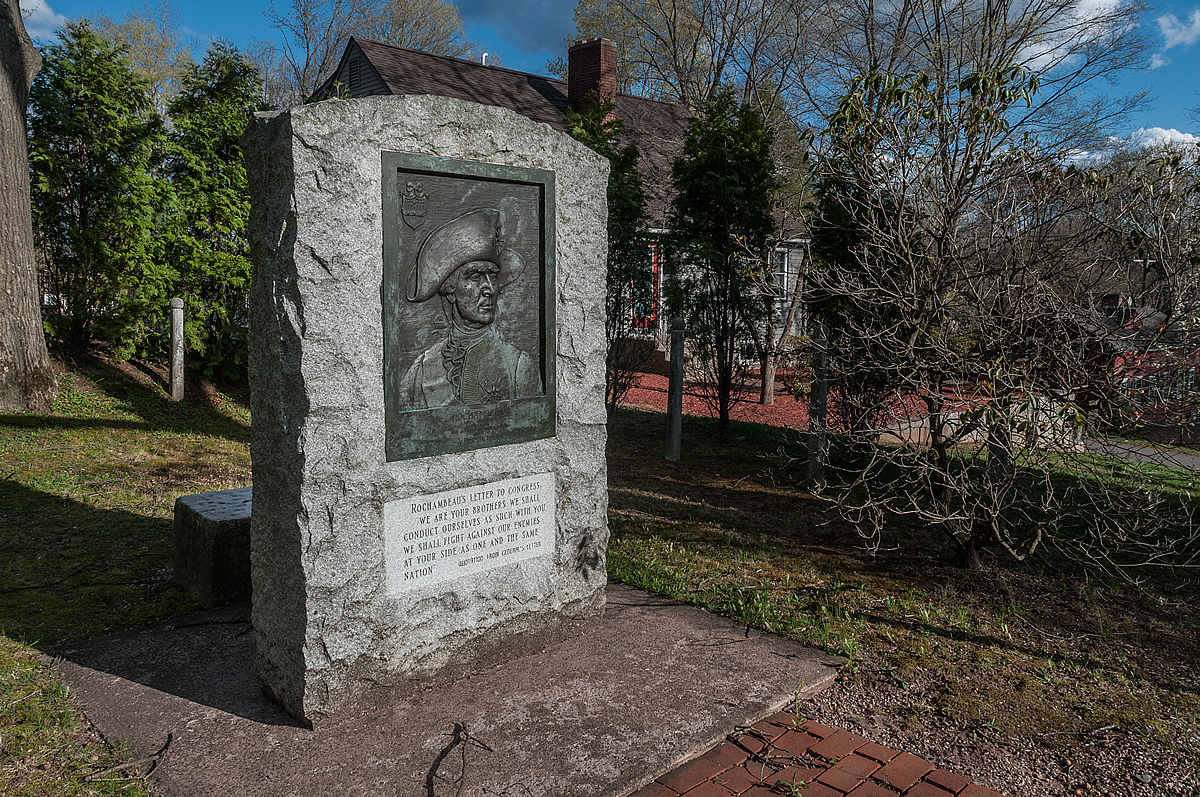

The French army led by Comte de Rochambeau crossed Connecticut after landing in Rhode Island, on its way to meet General Washington's army on the Hudson River. They then marched to Virginia to successfully besiege General Cornwallis' British army at Yorktown in the last campaign of the American Revolution. While at Southington, Rochambeau's army was accompanied by an Irish brigade, both on the way to Yorktown and on the way back. Although there were no strictly Irish units in Rochambeau's army itself, there were scattered Irish men, including a number of Irish officers. For instance, a 25-year-old Irish officer, Captain Isidore Lynch, was the aide-de-camp of Rochambeau's aide Comte Francois Jean de Chastellux.
 Photo: View southeast showing plaque and inscription. (Tod Bryant)
Photo: View southeast showing plaque and inscription. (Tod Bryant)
James Edward Kelly, sculptor and illustrator, specialized in depicting people and events surrounding the American Civil War, as well as the Revolutionary War. He was born on July 30, 1855 in New York City. He was the only surviving child of Patrick Paul and Julia Finley Kelly – his father being born in Glasgow of Irish parentage and his mother in Ireland.
As a child in New York City during the Civil War, Keely witnessed Union soldiers marching off to war and the draft riots of 1863. He was fascinated by newspaper accounts of battles that his parents read to him and he began to copy the heroic illustrations printed with them. His parents recognized his artistic talent and the sent him to the Academy Of Design at the age of fifteen.
He eventually became a founding member of The Art Students League where he studied with famed American illustrators Winslow Homer, Alfred Waud and Thomas Nast. He began his professional career in an era that has been called, The Golden Age of Illustration," and he found work in the magazines of the time, including St. Nicholas, Harper's Monthly and Scribner's Monthly.
Much of Kelly's artwork was of military subjects and depicted scenes from the Revolutionary and Civil Wars. In 1879, on assignment from his publishers, Kelly had the opportunity to meet and sketch over forty commanding generals of the Civil War, including his boyhood heroes – Ulysses S. Grant, William T. Sherman, and Philip Sheridan. Along with sketching their portraits, Kelly interviewed his subjects about their wartime experiences and carefully preserved those interviews in notebooks.
In the early 1880s, Kelly turned from illustration to bronze sculpture. This was during the American era of placing commemorative monuments at historical sites, and James Kelly was commissioned to make statues for several battlefields including Gettysburg, Saratoga, Monmouth and Brooklyn Heights. Kelly's historical depictions included Washington, Paul Revere, Molly Pitcher, Lafayette, General John Buford, Comte de Rochambeau and President Lincoln. His work achieved for him international fame, and in 1896, a leading art journal published a retrospective of Kelly's work, entitled, "James Edward Kelly – A Sculptor of American History."
Alas, after nearly six decades as a working artist with nearly 80 public and private bronzes placed throughout the United States, Kelly's fortunes declined with the arrival of modern sculpture and he quickly faded from the forefront of American art.
Kelly married Helen McKay (1871-1929) but no children survived them. He died penniless and alone in New York City in 1933 and was buried with his wife and her family (parents and sisters) in an unmarked grave in Saint Raymond's Cemetery in the Bronx.
Art historian William B. Styple, who had discovered Kelly's notebooks full of his interviews with Civil war generals in 2003, published a book on the artist and his work, Generals in Bronze , in 2005. The publication of the book renewed interest in Kelly and $8000 was raised to finally provide a headstone for the artists and his family. It was placed on the graves in 2013. The stone reads: James E. Kelly 1855-1933 – A Sculptor of American History.
Styple, William B. "James Kelly: A Sculptor of American History." Irish America. April/May 2013.
[ view source ]
"The Rochambeau Monument at Southington, Connecticut," Journal of the American Irish Historical Society, vol. 12, pp. 241-26
"1780-81: Connecticut's year of the French... and the Irish..." The Shanachie vol. 11, no. 2, March-April 2000
Monument paying tribute to Count de Rochambeau and other Frenchmen who under Lafayette aided the American colonies in their fight for independence. The site of the monument is French Hill, where Rochambeau's army encamped in 1781. The tablet, inscribed with the general's message to Washington, is on the monument site. The monument was erected by the Irish Historical Society of Providence.
Date(s): Built 1912 Artist: James Edward Kelly
Accessibility:
Exterior visible from public road.
The Irish experience has had a profound impact on Connecticut's past, and its narrative spans all periods of the state's history and touches every one of its eight counties and 169 towns.
